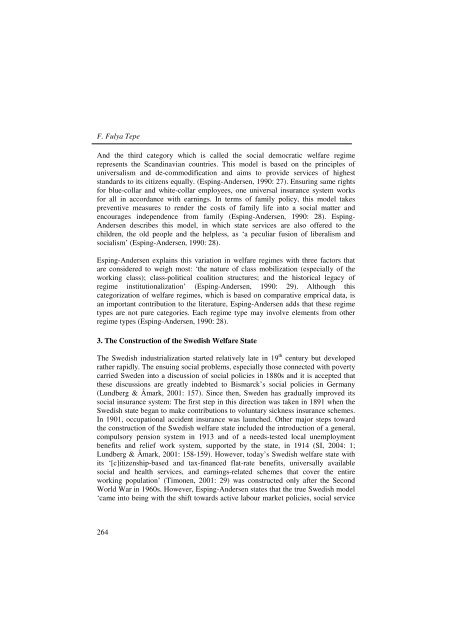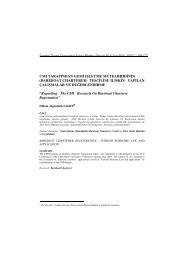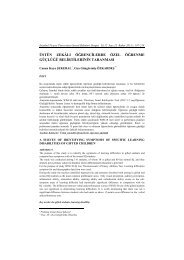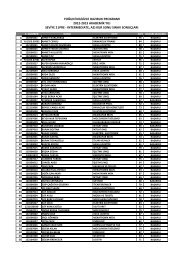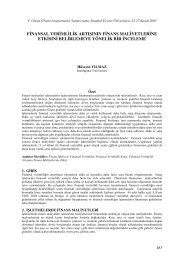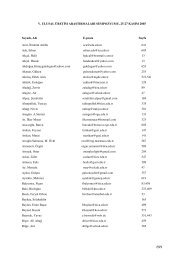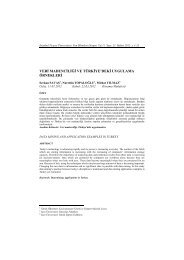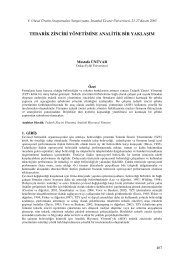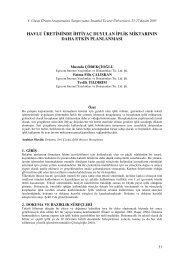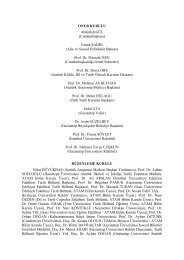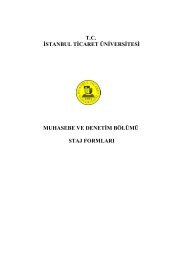an introduction to the swedish welfare state - Ä°stanbul Ticaret ...
an introduction to the swedish welfare state - Ä°stanbul Ticaret ...
an introduction to the swedish welfare state - Ä°stanbul Ticaret ...
Create successful ePaper yourself
Turn your PDF publications into a flip-book with our unique Google optimized e-Paper software.
F. Fulya TepeAnd <strong>the</strong> third category which is called <strong>the</strong> social democratic <strong>welfare</strong> regimerepresents <strong>the</strong> Sc<strong>an</strong>dinavi<strong>an</strong> countries. This model is based on <strong>the</strong> principles ofuniversalism <strong>an</strong>d de-commodification <strong>an</strong>d aims <strong>to</strong> provide services of highestst<strong>an</strong>dards <strong>to</strong> its citizens equally. (Esping-Andersen, 1990: 27). Ensuring same rightsfor blue-collar <strong>an</strong>d white-collar employees, one universal insur<strong>an</strong>ce system worksfor all in accord<strong>an</strong>ce with earnings. In terms of family policy, this model takespreventive measures <strong>to</strong> render <strong>the</strong> costs of family life in<strong>to</strong> a social matter <strong>an</strong>dencourages independence from family (Esping-Andersen, 1990: 28). Esping-Andersen describes this model, in which <strong>state</strong> services are also offered <strong>to</strong> <strong>the</strong>children, <strong>the</strong> old people <strong>an</strong>d <strong>the</strong> helpless, as ‘a peculiar fusion of liberalism <strong>an</strong>dsocialism’ (Esping-Andersen, 1990: 28).Esping-Andersen explains this variation in <strong>welfare</strong> regimes with three fac<strong>to</strong>rs thatare considered <strong>to</strong> weigh most: ‘<strong>the</strong> nature of class mobilization (especially of <strong>the</strong>working class); class-political coalition structures; <strong>an</strong>d <strong>the</strong> his<strong>to</strong>rical legacy ofregime institutionalization’ (Esping-Andersen, 1990: 29). Although thiscategorization of <strong>welfare</strong> regimes, which is based on comparative emprical data, is<strong>an</strong> import<strong>an</strong>t contribution <strong>to</strong> <strong>the</strong> literature, Esping-Andersen adds that <strong>the</strong>se regimetypes are not pure categories. Each regime type may involve elements from o<strong>the</strong>rregime types (Esping-Andersen, 1990: 28).3. The Construction of <strong>the</strong> Swedish Welfare StateThe Swedish industrialization started relatively late in 19 th century but developedra<strong>the</strong>r rapidly. The ensuing social problems, especially those connected with povertycarried Sweden in<strong>to</strong> a discussion of social policies in 1880s <strong>an</strong>d it is accepted that<strong>the</strong>se discussions are greatly indebted <strong>to</strong> Bismarck’s social policies in Germ<strong>an</strong>y(Lundberg & Åmark, 2001: 157). Since <strong>the</strong>n, Sweden has gradually improved itssocial insur<strong>an</strong>ce system: The first step in this direction was taken in 1891 when <strong>the</strong>Swedish <strong>state</strong> beg<strong>an</strong> <strong>to</strong> make contributions <strong>to</strong> voluntary sickness insur<strong>an</strong>ce schemes.In 1901, occupational accident insur<strong>an</strong>ce was launched. O<strong>the</strong>r major steps <strong>to</strong>ward<strong>the</strong> construction of <strong>the</strong> Swedish <strong>welfare</strong> <strong>state</strong> included <strong>the</strong> <strong>introduction</strong> of a general,compulsory pension system in 1913 <strong>an</strong>d of a needs-tested local unemploymentbenefits <strong>an</strong>d relief work system, supported by <strong>the</strong> <strong>state</strong>, in 1914 (SI, 2004: 1;Lundberg & Åmark, 2001: 158-159). However, <strong>to</strong>day’s Swedish <strong>welfare</strong> <strong>state</strong> withits ‘[c]itizenship-based <strong>an</strong>d tax-fin<strong>an</strong>ced flat-rate benefits, universally availablesocial <strong>an</strong>d health services, <strong>an</strong>d earnings-related schemes that cover <strong>the</strong> entireworking population’ (Timonen, 2001: 29) was constructed only after <strong>the</strong> SecondWorld War in 1960s. However, Esping-Andersen <strong>state</strong>s that <strong>the</strong> true Swedish model‘came in<strong>to</strong> being with <strong>the</strong> shift <strong>to</strong>wards active labour market policies, social service264


